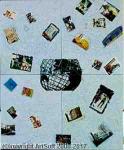Howardena Pindell
Howardena Pindell
Style: Postcolonial Art;
Place: Philadelphia
Born: 1943
Biography:
Howardena Pindell is an American abstract artist. Her work explores texture, color, structures, and the process of making art; it is often political, addressing the intersecting issues of racism, feminism, violence, slavery, and exploitation. She is known for her use of unconventional materials in her paintings including string, perfume, glitter, and postcards.
Pindell was born in Philadelphia, Pennsylvania in 1943 to Howard and Mildred (née Lewis) Douglas. She had a middle-class upbringing in Philadelphia. Her parents always placed extraordinary emphasis on neatness, which would later be visible in her artwork. At the age of 8, she had already declared that she wanted to be an artist.
Pindell graduated from the Philadelphia High School for Girls. From a young age, she demonstrated promise in figurative art classes at the Philadelphia College of Art, the Fleisher Art Memorial, and the Tyler School of Art. She received her BFA from Boston University in 1965 and her MFA from Yale University in 1967. She also holds honorary doctorates from the Massachusetts College of Art and Design and Parsons The New School for Design.
Though she initially began her practice with figurative paintings, once she earned her MFA and moved to New York, her style would change dramatically. After graduating from Yale, she began working at the Museum of Modern Art (MoMA) in New York City, where she was employed from 1967-1979 as an exhibit assistant, curatorial assistant, and associate curator. In 1972, Pindell was a founding member of A.I.R. Gallery, her feminist interest proved to be a pivotal step to her political activism. At the first meeting of AIR Gallery, Pindell had suggested the name of the Jane Eyre. In 1977, she became associate curator of the department of Prints and Illustrated Books. She continued to spend her nights creating her own pieces, drawing inspiration from many of the exhibits hosted by MoMA, especially the museum's collection of Akan batakari tunics in the exhibit African Textiles and Decorative Arts. Because her days were taken up with work at the MoMA, some say that her work shifted from figurative to abstract because she could no longer rely on natural light and a model to be present when she worked at night.
In the mid-1970s, she began travelling abroad as a guest speaker and lecturer. Her seminars included "Current American and Black American Art: A Historical Survey" at the Madras College of Arts and Crafts in India 1975, and "Black Artists, U.S.A." at the Academy of Art in Oslo, Norway 1976.
Currently, Pindell is a professor of art at Stony Brook University, where she has taught since 1979. From 1995–1999, she worked as a visiting professor in the art department at Yale University. Since leaving her job at MoMA to become a professor, Pindell has had more time for both art making and political activism. Throughout her entire artistic career, Pindell has written in many publications addressing the racism she has personally faced in the art world, as well as the biases the art world projects onto other artists. She has looked at statistics about how many artists of color and women get gallery and museum shows, compared to their more highly acclaimed white male counterparts. She has also questioned the role of the art critic and hypothesizes that value judgements are deeply intertwined with racism and sexism. Though her art is often abstract, these themes are addressed quite frequently.
Pindell had known she wanted to be an artist since age 8, but over the years her style has evolved, as has her subject matter. The first shift occurred after she received her masters from Yale in 1967. It was in this time, after moving to New York, when she began her work with abstraction and collaging, finding inspiration in the work of fellow grad school student Nancy Murata. Her earliest paintings had been mostly urban scenes, but in the 1970s, she began developing a unique style seemingly rooted in minimalism and pointillism. As she experimented with the process of creating her paintings, Pindell began making use of the scrap circles of oaktag paper that resulted from the production of her pointillist works. As David Bourdon writes, "By 1974, Pindell developed a more three-dimensional and more personal form of pointillism, wielding a paper punch to cut out multitudes of confetti-like disks, which she dispersed with varying degrees of premeditation and randomness over the surfaces of her pictures."
In 1969, Pindell gained recognition for her participation in the exhibition American Drawing Biennial XXIII at the Norfolk Museum of Arts and Sciences, and by 1972, had her first major exhibition at Spelman College in Atlanta. In 1973, her work with circles received acclaim at a show in the A.I.R. (Artists-In-Residence) Gallery in SoHo (which she helped to found), where her style had solidified into expression through "large-scale, untitled, nonrepresentational, abstract paintings".
More...
Wikipedia link: Click Here








